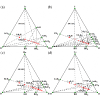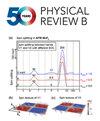Superconducting properties of rare-earth boron hydrides at high pressure studied by first-principles calculations
IF 3.7
2区 物理与天体物理
Q1 Physics and Astronomy
引用次数: 0
Abstract
It is a long-thought proposal that dense light-element molecular hydrides, such as diborane () and methane (), offer an ideal platform to search for phonon-mediated superconductors. However, these hydrides are often unstable under sufficiently high pressure, e.g., decomposed into BH and at pressures of above 153 GPa, which are unlikely to exhibit high superconductivity. Here, we find a feasible route to stabilize these light-element molecular hydrides with high superconductivity under high pressure by high-throughput structure searches and first-principles calculations. We uncover a series of stable H-rich rare-earth () metal based boron hydrides with polydiborane networks. Strikingly, is predicted to be a high-temperature superconductor with unprecedentedly critical temperature ( ) of up to 93 K under 150 GPa. The present findings open a route to stabilize the unstable diborane by bringing the additional metals into the lattice under high pressure, as well as tuning the superconductivity among diborane-based hydrides and other similar dense light-element molecular hydrides.

通过第一原理计算研究高压下稀土硼氢化物的超导特性
长期以来,人们一直认为二硼烷(B2H6)和甲烷(CH4)等高密度轻元素分子氢化物为寻找声子介导的超导体提供了理想平台。然而,这些氢化物在足够高的压力下通常是不稳定的,例如,B2H6 在 153 GPa 以上的压力下分解为 BH 和 H2,不太可能表现出高超导性。在这里,我们通过高通量结构搜索和第一原理计算,找到了在高压下稳定这些具有高超导性的轻元素分子氢化物的可行途径。我们发现了一系列具有多二硼烷网络的稳定的富氢稀土(R)金属基硼氢化物 RB2H10。引人注目的是,YB2H10 被预测为一种高温超导体,在 150 GPa 下的临界温度(Tc)可达 93 K,这是前所未有的。目前的发现开辟了一条在高压下将额外的 R 金属引入晶格以稳定不稳定的二硼烷的途径,同时也调整了二硼烷基氢化物和其他类似致密轻元素分子氢化物之间的超导性。
本文章由计算机程序翻译,如有差异,请以英文原文为准。
求助全文
约1分钟内获得全文
求助全文
来源期刊

Physical Review B
物理-物理:凝聚态物理
CiteScore
6.70
自引率
32.40%
发文量
0
审稿时长
3.0 months
期刊介绍:
Physical Review B (PRB) is the world’s largest dedicated physics journal, publishing approximately 100 new, high-quality papers each week. The most highly cited journal in condensed matter physics, PRB provides outstanding depth and breadth of coverage, combined with unrivaled context and background for ongoing research by scientists worldwide.
PRB covers the full range of condensed matter, materials physics, and related subfields, including:
-Structure and phase transitions
-Ferroelectrics and multiferroics
-Disordered systems and alloys
-Magnetism
-Superconductivity
-Electronic structure, photonics, and metamaterials
-Semiconductors and mesoscopic systems
-Surfaces, nanoscience, and two-dimensional materials
-Topological states of matter
 求助内容:
求助内容: 应助结果提醒方式:
应助结果提醒方式:


